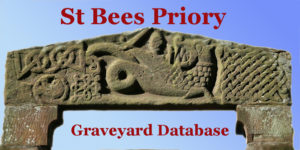Graveyard Regulations
The Carlisle Diocese, in common with all Dioceses, issues guidance notes and applies a number of regulations to burials in the church graveyard. The full Diocesan Regulations on Graveyards are available on the Diocesan web site.
We also have an area used for the burial of cremated remains. There are a number of local regulations applied to such burials. These are shown below.
St Bees Priory Church
Interment of Cremated Remains
The Priory Churchyard has two areas for cremated remains. At the south-west corner of the Churchyard, there is a “Garden of Remembrance” for the interment of ashes with no memorial stones. This area is for the disposal of ashes (not in caskets) in perpetuity, and as such there are no individual plots and no memorial stones.
Adjacent to the Lych Gate, there is a memorial area with provision for individual plots identified by memorial stones. Ashes should preferably be buried without their container but if a container is used, it must be made from a biodegradable material.
St Bees Priory Church – Interment of Cremated Remains
The Priory Churchyard has two areas for cremated remains. At the south-west corner of the Churchyard, there is a “Garden of Remembrance” for the interment of ashes with no memorial stones. This area is for the disposal of ashes (not in caskets) in perpetuity, and as such there are no individual plots.
Adjacent to the Lych Gate, there is a memorial area with provision for individual plots identified by memorial stones. Ashes should preferably be buried without their container but if a container is used, it must be made from a biodegradable material. However due to severe space limitations in this area, permission will only be granted to those who either** have lived in the parish of St Bees for at least 5 years;
Allocation of spaces should be agreed with the Priory Graveyard Officer or Deputy. Ashes will only be interred in this area if a memorial stone is planned, which must be placed within 6 months. (In the interim, the plot must be marked with a temporary metal, plastic or wooden marker). If no memorial stone is planned, ashes cannot be interred in this area and should be interred in the “Garden of Remembrance” referred to above.
** were born in the village, but if they had left the village, had lived here for at least 10 years before leaving;
** had close family (siblings, parents or grandparents) buried in the St Bees Priory graveyard;
** had strong connections with St Bees Priory or village;
**or had been regular attenders at St Bees Priory
Those to whom we are unable to offer a burial plot may have the cremated remains buried in the Garden of Remembrance and an entry placed in the Book of Remembrance.There are some simple rules for the types and siting of stones:
Memorial stones must be flat, with no carved relief, and must measure 450mm x 450 mm (18” x 18”).
They may be of any natural stone or marble, and of any finish, excepting all white, which does not blend with the environment.
Sandstone is not recommended when laid flat, due to poor weather resistance.
Caskets or ashes must be placed in the allocated space and memorial stones placed as indicated in the attached diagram.
Stones shall be spaced 230 mm (9”) apart horizontally.
Memorials in the lower (south) row should leave a 250 mm (10”) space above the stone, and stones in the upper (north) area should leave a 150 mm (6”) from the path. A small vase or other receptacle for flowers may be placed above the memorial stone.
N.B. Stones in the upper (north) area will need to be orientated the opposite way from all others to allow the inscription to be read from the path.
Plots are allocated sequentially by the Priory Graveyard Officer or his deputy. Specific plots may not be selected.
Stones must be laid flush with the existing surface of the kerbed area. Care must be exercised to ensure that they are laid in line with existing stones and they must be cemented to an underlying paving slab or concreted squarely in place to prevent unauthorised removal.
Memorial stones should not be placed on top of visible paving slabs.
No plants should be planted adjacent to the memorial stone. In order to avoid roots rooting into the ground, any planters or troughs must be placed on a suitable slate or other base rather than directly on the ground. It is preferable that non-perforated planters are used. Plants which root through their containers or are planted directly in the ground will be removed as these will grow too large and produce maintenance problems.The PCC reserves the right to recall the undertaker (at the applicant’s expense) within a reasonable time to make good any unsatisfactory workmanship, including placing a basic memorial stone if the applicant does not do so within a reasonable time.
Priory Graveyard Officers
Dr Ian W McAndrew, South Winds, Outrigg, St Bees, Cumbria, CA27 0AN.
Tel. 01946 822326 / 0770 956 3294. Email – imcandrew@stbees.org.ukMr Derek McGee, Churchwarden, Briary Bank, Middletown, CA22 2UG.
Tel. 01946 820474. Email – dm.mcgee@btinternet.comIssued by the Parochial Church Council of St Bees Priory, October 2015.
